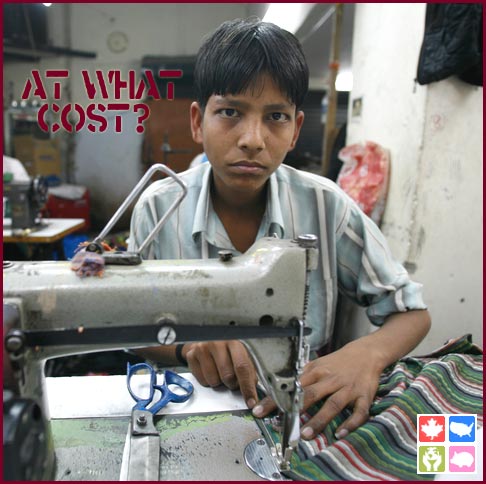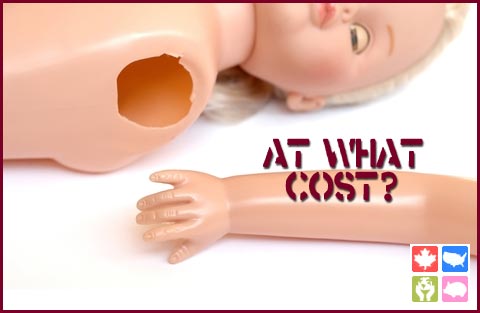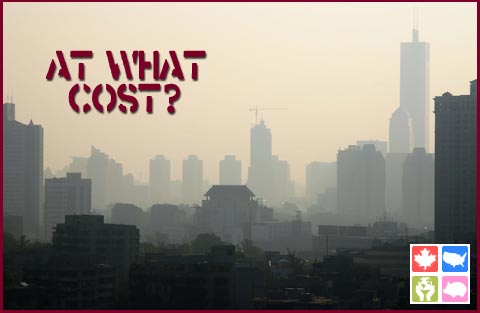
Last year, in answer to a lot of questions we received about why we focus so much on products made in North America, we outlined the issues with cheap imports. The real cost goes a lot deeper than price. Low price usually means that some of the real costs of materials, production, and transportation are externalized—meaning others pay the short-term and the long-term cost of the low price.
We want you to understand the basic issues that concern us with production away from home, away from the consistent scrutiny of regulations intended to uphold basic standards of labour, safety, quality, and environmental responsibility. We want you to understand how we see these issues as connected to genuine sustainability.
Cheap Products at What Cost?
Cheaper products sometimes carry hidden costs to labour, safety, quality, environment, and sustainability of your community.
We set high basic standards for every product we carry. We start by looking close to home, then across Canada, across North America, and only then do we consider looking overseas for products to meet your needs.
In “Cheap Products at What Cost?” we share with you the actual questions we ask before we consider a new supplier.
Imports at What Cost? Labour

Outsourcing labour and importing cheap goods can mean that workers who produce those goods are not fairly paid. Those workers pay the real cost of cheap imports.
When we reach for cheap products, they don’t cost any less than the expensive products. They just externalize costs—that is, someone else pays the true cost of the product. When the factor that allows the cost to stay low is labour, the person who works in the field or in the factory for less than a fair wage is the one who pays. The real cost of goods includes the consequences of unpaid labor.
Organizations throughout the world investigate slave labour and child labour so you can choose products with some confidence that you know how they were made.
In “Imports at What Cost? Labour,” we look at the consequences of unpaid and underpaid labour.
Imports at What Cost? Safety

Buying cheap imports that use inferior materials, shortcuts in assembly, or even badly copied designs to keep costs low can be a safety risk for your child.
When that product is inexpensive at the cost of safety, though, it is your baby who can pay. Injury or worse because of an unsafe baby product is part of the real cost of products that are made not to meet the needs of babies.
We take seriously standards of safety, quality of materials, and quality of work. We work with companies that understand the products they make and make they well.
Read “Imports at What Cost? Safety” to learn more about how you can be confident the products you buy meet high safety standards.
Imports at What Cost? Quality

When you buy low-quality imports, you pay in safety and durability—and sometimes you pay at the store twice when you replace cheap products.
Quality isn’t necessarily your primary concern when you are looking for low-cost toys, diapers, clothing, and other children’s products. Many companies outsource production to keep costs low, which allows importers to sell to North American markets at lower prices than products Made in Canada or Made in USA. Often quality suffers for cost.
Quality and safety issues overlap. Quality can also mean an issue of durability when toys break as soon as children play with them.
Read “Imports at What Cost? Quality” to learn more about the toy recalls of 2007 that sparked a new wave of children’s product safety laws in Canada and the United States.
Imports at What Cost? Environment

When we buy products made somewhere without tight environmental regulations, the price we pay doesn’t cover the costs of environmental damage. Those costs are paid by the state of origin, the local community, and the workers.
Products made in Canada or the U.S. are produced in compliance with strict regulations. When you buy imports, you have few assurances that making the products did not cause local harm through air or water pollution. Damage to environment and to health through the environment are part of the real cost of imports. We pay now, or we pay later, but we will pay.
In “Imports at What Cost? Environment,” read about the environmental impact in first Mexico and now China of production for export the North American market.
Imports at What Cost? Sustainability

Truly sustainable products don’t pass on real costs to others but accept and embrace the real costs, redesigning the product and the supply chain not to externalize the costs but to internalize the benefits.
Cheap imports are cheap precisely because they cut costs by cutting corners—pay less for labour, think less about quality, design less for safety, and don’t worry about the environment. Good business? Only in the moment. In the long term, these short-term savings leave us with big bills to pay.
Learn what sustainability looks like in “Imports at What Cost? Sustainability.”
What is the solution? Buy local. Local businesses are better at understanding your needs, and local businesses contribute to your community in ways that help you, them, and all of your neighbors.
